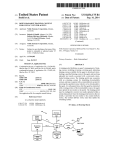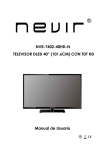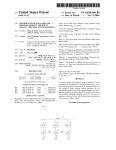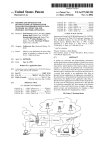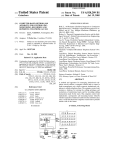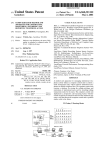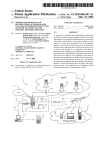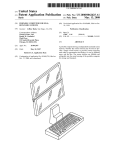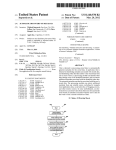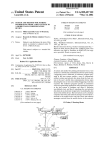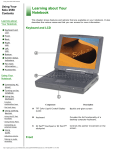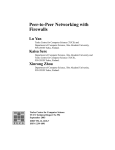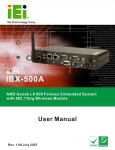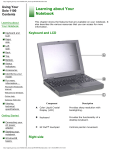Download Portable internet browser device with cordless phone module and
Transcript
US006952414B1 (12) United States Patent (10) Patent N0.: (45) Date of Patent: Willig (54) PORTABLE INTERNET BROWSER DEVICE WITH CORDLESS PHONE MODULE AND METHOD OF OPERATION (75) Sunnyvale, CA (US) Notice: Borella et a1. .... .. 370/230 Newman et a1. ....... .. 455/556.1 Newman et a1. .......... .. 455/556 * cited by examiner Subject to any disclaimer, the term of this patent is extended or adjusted under 35 Primary Examiner—Wellington Chin USC 154(b) by 812 days. Assistant Examiner—Mark A Mais (21) Appl. No.: 09/669,709 (57) ABSTRACT Sep. 26, 2000 (22) Filed: (51) (52) Int. Cl.7 ................... .. ........................ .. US. Cl. ............ .. There is disclosed a personal access device (PAD) capable of browsing web sites on an Internet protocol (IP) network and also capable of operating as a cordless phone that provides H04L 12/50 370/352; 379/9309; 379/110.01; 345/650; 345/169 Field of Search ...... .. ...................... .. a conventional phone connection or a voice-over-IP phone connection. The personal access device comprises: 1) a radio 370/352, 353, 370/354, 355, 379/8811, 90.01, 90.02, 92.04, 379/9305, 100.05, 100.15, 93.09, 102.02, 379/110.01, 201.04, 345/650, 168, 169, 179—182, frequency (RF) transceiver for wirelessly communicating with a base station coupled to the IP network, wherein the RF transceiver transmits IP data packets to the base station and receives IP data packets from the base station; and 2) a PAD controller for executing an Internet browser application and displaying web pages associated with the web sites on a display screen of the personal access device. The PAD 345/520, 1.1, 2.1 References Cited (56) U.S. PATENT DOCUMENTS 5,983,073 6,112,099 6,359,892 6,418,146 6,477,565 Thakker ................... .. 709/230 7/2003 6/2004 2/2002 W. Richard Stevens, TCP/IP Illustrated: The Protocols, 1994, Addison-Wesley, vol. I, pp. 34-35.* U.S. Appl. No. 09/443,024, ?led Nov. 1999, Newman et al.* (73) Assignee: Advanced Micro Devices, Inc., (58) 11/2002 6,587,433 B1 * 6,757,551 B2 * 2002/0022499 A1 * OTHER PUBLICATIONS (Us) (*) Oct. 4, 2005 6,487,602 B1 * Randy C. Willig, Fort Collins, CO Inventor: US 6,952,414 B1 A A B1 B1 B1 * 11/1999 * 8/2000 * 3/2002 * 7/2002 * 11/2002 DitZik ..................... .. 455/11.1 Ketola . . . . . . . . .. SZlam . . . . . . . . . . . . .. Miloslavsky controller is also capable of transmitting voice data to, and receiving voice data from, the base station via the RF transceiver. 455/466 370/401 370/400 24 Claims, 3 Drawing Sheets Daswani et a1. .......... .. 709/217 505 OUTGOING CALL? INCOMING CALL? YES ALERT USER ENTER PHONE NUMBER 515 I DETECT SEPARATION OF USER CONTROL MODULE 120 L EXECUTE PHONE CALL APPLICATION END CALL; ATTACH UNIT 525 U.S. Patent 0a. 4,2005 110 US 6,952,414 B1 105 100 1°\° Sheet 1 of3 120 FIG. 1 ?/ STATION BASE U TO/FROM INTERNET \ 200 O FIG. 2 300 30s\ / LOW-LATENCY BITS FIG. 3 U.S. Patent 0a. 4,2005 Sheet 2 of3 US 6,952,414 B1 105 120 / / 4s0\ _ 4 MICROCONTROLLER f432 \ V — 40\5 4510 > MEMORY 4/25 VIDEO 5 AUDIO/ AUDIO < IF / f1so 44g ~ | _ KEYPAD v INIPFUT ‘ CONT 30 USER BUTTONS INPUT < > IF TX 1’ > PROQ : A 415 < \I /130 USER /4 = INPUTS 434 t M|C /140 SPKH [150 \45o v SENSOR ‘ ‘ / ‘ ' X-CVR. \ 42o RF , _Y 460 U ‘ ’ P360. / 455 FIG. 4 ’ U.S. Patent Oct. 4, 2005 Sheet 3 of3 US 6,952,414 B1 START 100 F ______________________________________ _ -Z _______ _ -1 I ' I I > EXECUTE BROWSER APPLICATION I ; / 505 I I 1 INCOMING I 1 CALL? YES < I I I 510 NO OUTGOING NO I : CALL? YES 540 I : l l I II ' ALERT I USER I II \ 515 ENTER PHONE NUMBER l I I \ ' I 545 I l II I I DETECT SEPARATION OF I I I UsER CONTROL MODULE < 120 \ 520 I I l l l I ; I | I’ I EXECUTE PHONE \ CALL APPLICATION 525 I l I I I I I I I I’ ENO CALL; ATTACH UNIT \ 5'30 I i I I _______________________________________________ _ _I US 6,952,414 B1 1 2 PORTABLE INTERNET BROWSER DEVICE WITH CORDLESS PHONE MODULE AND METHOD OF OPERATION separate Internet telephone in order to use the Internet for phone service. This further adds to the consumer’s equip TECHNICAL FIELD OF THE INVENTION enabled devices that alloW a user to access the Internet for ment costs. There is therefore a need in the art for improved Web a Wide variety of applications. In particular, there is a need for a Web-enabled personal access device (PAD) that is The present invention is generally directed to handheld computers and similar personal digital assistant (PDA) capable of broWsing Internet Web sites and capable of devices and, more speci?cally, to a portable Internet broWser device that incorporates a cordless phone module. operating as an Internet telephone. 10 SUMMARY OF THE INVENTION BACKGROUND OF THE INVENTION The personal computer (PC) has become ubiquitous in society. Personal computers are used in the home and in the office for a variety of purposes, one of the most important of 15 Which is accessing the Internet. Apersonal computer may be of operating as a cordless phone that provides a conventional phone connection and a voice-over-IP phone connection. According to an advantageous embodiment of the present invention, the personal access device comprises: 1) a radio used to broWse Web sites and to send and to receive e-mail. The average price of a personal computer has fallen to the point Where it is affordable to most of the population, Which frequency (RF) transceiver capable of Wirelessly communi further increases the importance of Internet applications. Despite the popularity of the personal computer, it is eXpected that future Internet development Will focus on non-PC devices that are capable of accessing the Internet. These “Web-enabled” devices include many conventional To address the above-discussed de?ciencies of the prior art, it is a primary object of the present invention to provide a personal access device (PAD) capable of broWsing Web sites on an Internet protocol (IP) netWork and also capable 25 cating With a base station coupled to the IP netWork, Wherein the RF transceiver transmits IP data packets to the base station and receives IP data packets from the base station; and 2) a PAD controller capable of executing an Internet appliances (e.g., stereos, refrigerators, and the like) that may broWser application and displaying Web pages associated access the Internet for any number of purposes, such as With the Web sites on a display screen of the personal access notifying the manufacturer of a malfunction, doWnloading a device, Wherein the PAD controller is further capable of transmitting voice data to, and receiving voice data from, the softWare upgrade from the manufacturer, transmitting oWner Warranty information to the manufacturer, and the like. telephones as “voice-over-IP” technology becomes more base station via the RF transceiver. According to one embodiment of the present invention, the PAD controller transmits the voice data to, and receives fully developed. the voice data from, the base station in Internet protocol (IP) Internet telephones may eventually replace conventional data packets. Consumers Will use a variety of different devices to surf the Web. BroWser capability is being added to mobile 35 According to another embodiment of the present inven phones, personal digital assistant (PDA) devices and elec tion, the PAD controller and the base station establish a loW tronic organiZers, such as the Palm VII organiZer, televi latency connection for transmitting and receiving the IP data packets containing the voice data. sions, and the like. More recently, Web-enabled personal access devices (PADs) have become available. These PADS are tablet-siZed “Web terminals” that resemble stripped According to still another embodiment of the present 40 application capable of transmitting and receiving the IP data doWn laptop personal computers. The PAD eXecutes selected Internet-related applications, including a broWser packets. In one embodiment of the present invention, the personal access device further comprises a microphone for detecting program and an e-mail program. The PAD user interface typically is an LCD touch screen, a mouse-like pointing device (e.g., a scroll pad), and a softWare keyboard operated by the touch screen. The PAD may communicate by Wireline or Wirelessly With the Internet. In a Wireless environment, the PAD communicates Wirelessly With a base station that is invention, the PAD controller eXecutes a voice-over-IP 45 the voice of a user and a speaker for transmitting an incoming voice signal to the user. In another embodiment of the present invention, the personal access device comprises a display screen module capable of housing the display screen and a user control module removably attached to the display screen module, connected by Wireline to the public sWitched telephone netWork or to a proprietary local area netWork A Wireless PAD alloWs the user to move around the home or Wherein the RF transceiver and the PAD controller are disposed in the user control module. office While broWsing the Internet. The base sation may be incorporated in a cradle that normally holds and recharges While the different types of Web-enabled devices are intended to offer cheaper, more user-friendly access to the Internet than a conventional personal computer, many cost In still another embodiment of the present invention, the microphone and the speaker are disposed in the user control module. In yet another embodiment of the present invention, the PAD controller is capable of determining When the user control module and the display screen module are separated. In a further embodiment of the present invention, the PAD savings are not realiZed because of the redundancy in controller, in response to a determination that the user hardWare or softWare functions of these Web-enabled devices. For example, a PAD such as the GeodeTM Web PADTM system and a Palm VII organiZer both contain an LCD screen and a Wireless transceiver. Additionally, much control module and the display screen module are separated, establishes a loW latency connection to the base station for the PAD When it is not in use. An eXample of a Web-enabled personal access device (PAD) is the GeodeTM WebPADTM system from National Semiconductor Corporation. of the softWare in these devices also is redundant. Moreover, PADs and electronic organiZers do not provide the function ality of a telephone, so that a consumer must still oWn a 55 transmitting and receiving the voice data. The foregoing has outlined rather broadly the features and 65 technical advantages of the present invention so that those skilled in the art may better understand the detailed descrip tion of the invention that folloWs. Additional features and US 6,952,414 B1 3 4 advantages of the invention Will be described hereinafter that form the subject of the claims of the invention. Those skilled in the art should appreciate that they may readily use the conception and the speci?c embodiment disclosed as a basis for modifying or designing other structures for carry ing out the same purposes of the present invention. Those skilled in the art should also realiZe that such equivalent constructions do not depart from the spirit and scope of the invention in its broadest form. Before undertaking the DETAILED DESCRIPTION OF THE INVENTION beloW, it may be advantageous to set forth de?nitions of certain Words and phrases used through FIG. 1 illustrates eXemplary modular personal access device (PAD) 100 according to one embodiment of the present invention. PAD 100 comprises display module 105 and user control module 120. Display module 105 comprises display screen 110 and speakers 115a and 115b. Internally, user control module 120 comprises the necessary data processors and memory necessary to run applications (e.g., broWser and e-mail) that access the Internet. As Will be eXplained beloW in greater detail, user control module 120 also comprises Wireless transceiver circuitry that provides PAD 100 With an Internet cordless phone capability. User control module 120 comprises pointing device 125, out this patent document: the terms “include” and “com prise,” as Well as derivatives thereof, mean inclusion Without limitation; the term “or,” is inclusive, meaning and/or; the Which may be, for eXample, a mouse-type device or touch pad that enables a user to move a cursor on display screen 15 110. User control module 120 also comprises a plurality of control buttons 130 (generally denoted by dotted line), phrases “associated With” and “associated thereWith,” as Well as derivatives thereof, may mean to include, be microphone 140, speaker 150 and (optional) telephone key included Within, interconnect With, contain, be contained pad 160. Control buttons 130 may include, among others, the folloWing keys or buttons: ENTER, VOLUME UP/DOWN, Right Mouse, Left Mouse, UP/DOWN arroWs, LEFT/RIGHT arroWs, END, DELETE, ESC, TAB, and the Within, connect to or With, couple to or With, be communi cable With, cooperate With, interleave, juXtapose, be proXi mate to, be bound to or With, have, have a property of, or the like; and the term “controller” means any device, system or part thereof that controls at least one operation, such a device may be implemented in hardWare, ?rmWare or soft like. A user broWses the Internet and eXecutes applications by maneuvering pointing device 125 and pressing control buttons 130. The user also may enter alphanumeric charac Ware, or some combination of at least tWo of the same. It 25 ters on telephone keypad 160. In an advantageous embodi should be noted that the functionality associated With any particular controller may be centraliZed or distributed, Whether locally or remotely. De?nitions for certain Words ment of the present invention, display screen 110 is a touch screen that alloWs the user to enter alphanumeric teXt by touching virtual buttons on an on-screen QWERTY key and phrases are provided throughout this patent document, board. those of ordinary skill in the art should understand that in many, if not most instances, such de?nitions apply to prior, as Well as future uses of such de?ned Words and phrases. plary modular PAD 100 and corresponding base station 200 according to one embodiment of the present invention. Base FIG. 2 illustrates an Internet set-up connection of eXem station 200 may be connected to the Internet by any knoWn BRIEF DESCRIPTION OF THE DRAWINGS For a more complete understanding of the present inven tion, and the advantages thereof, reference is noW made to the folloWing descriptions taken in conjunction With the accompanying draWings, Wherein like numbers designate like objects, and in Which: FIG. 1 illustrates an eXemplary modular personal access technique, including by cable modem, by digital subscriber 35 public sWitched telephone system (PSTN), by ?Xed Wireless connection, and the like. In an advantageous embodiment of the present invention, base station 200 comprises recharging circuitry and a holding cradle, alloWing PAD 100 to be 40 device (PAD) according to one embodiment of the present FIG. 2 illustrates an Internet set-up connection of the 45 and receives IP packets from base station 200. PAD 100 and base station 200 may communicate using any conventional radio frequency (RF) access protocol, including one or more of code division multiple access (CDMA), frequency divi sion multiple access (FDMA), and time division multiple tion; FIG. 3 illustrates an eXemplary IP packet transmitted from access (TDMA), or any combination of such protocols. A conventional cordless phone comprises a handset and a base station, both of Which contain RF transceivers that the user control module to the base station according to one embodiment of the present invention; FIG. 4 illustrates an eXemplary modular PAD in greater detail according to one embodiment of the present invention; and FIG. 5 is a How diagram illustrating the operation of the eXemplary modular PAD according to one embodiment of the present invention. recharged When not in use. When a user is broWsing the Internet, PAD 100 Wirelessly transmits Internet protocol (IP) packets to base station 200 invention; eXemplary modular PAD in FIG. 1 and a corresponding base station according to one embodiment of the present inven line (DSL), by conventional 56K analog modem to the communicate voice signals Wirelessly, thereby permitting a person to move freely around the home or of?ce. Advanta geously, the RF transceiver circuitry found in PAD 100 and 55 base station 200 are similar to the RF transceiver circuitry found in the handset and base station of a cordless phone. The present invention capitaliZes on these similarities by alloWing a person to make and to receive telephone calls via DETAILED DESCRIPTION OR THE INVENTION user control module 120, Which functions as a cordless phone handset. FIGS. 1 through 5, discussed beloW, and the various embodiments used to describe the principles of the present invention in this patent document are by Way of illustration only and should not be construed in any Way to limit the scope of the invention. Those skilled in the art Will under stand that the principles of the present invention may be implemented in any suitably arranged Web-enabled personal access device Auser may initiate a telephone call by entering a number on (optional) telephone keypad 160. If telephone keypad 65 160 is not implemented in user control module 120, the user may enter the number using the touch screen capability of display screen 110. In an advantageous embodiment of the present invention, When the user has entered the number, the call may be initiated by separating user control module 120 from display module 105. When user control module 120 US 6,952,414 B1 5 6 detects that it has been detached from display module 105, instead. Sensor 420 generates an output signal that indicates user control module 120 stops operating in a Web broWser Whether or not user control module 120 and display module mode and begins operating in a cordless phone mode. The 105 are connected. entered number is dialed out to the PSTN by base station 200. Alternatively, in a voice over IP application, base station 200 initiates a phone call via the Internet to the PSTN. Similarly, a call may be ansWered When base station 100 User control module 120 comprises sensor 420, audio video interface (IF) 425, user input IF 430, microcontroller 432, memory 434, user input IF 440, transmission process ing circuitry 450, receiver processing circuitry 455, radio frequency (RF) transceiver (X-CVR) 460, all of Which are coupled together by, and communicate via, communication transmits a call noti?cation message to PAD 100. When user control module 120 detects the call noti?cation message, an 10 audible indicator (e.g., ring tone) or a visible indicator (e.g., message box) alerts the user, Who may ansWer the call by separating user control module 120 from display module 105. Again, When user control module 120 detects that it has been detached from display module 105, user control mod ule 120 stops operating in a Web broWser mode and begins operating in a cordless phone mode. When user control bus 480. When a user is broWsing the Internet, microcon troller 432 transmits video and audio signals associated With the Web broWser application to display module 105 via audio-video IF 425. Similarly, user inputs from the touch screen are transmitted from display screen 110 to microcon 15 troller 432 via user input IF 430. module 120 is being used in cordless phone mode, micro phone 140 detects the user’s voice and speaker 150 plays the Memory 434 stores application programs executed by microcontroller 432 and data used by the application pro grams. Memory 432 may be any conventional memory, including static random access memory (RAM), dynamic incoming voice signal to the user. FIG. 3 illustrates exemplary IP packet 300 transmitted from user control module 120 to base station 200 according RAM, and ?ash RAM. Microcontroller 432 may include any conventional data processor, including an x86-based micro processor. User input IF 440 receives user manual inputs to one embodiment of the present invention. When a user is from optional telephone keypad 160, pointing device broWsing the Internet, IP packets are transmitted and received by PAD 100 and base station 200 in “non-real” time. That is, there is neither a guaranteed maximum delay (mouse) 125, and control buttons 130. Transmission processing circuitry 450 comprises a voice processor, such as a digital signal processor (DSP), capable of receiving an analog voice signal from microphone (MIC) 25 for IP packets nor a minimum transfer rate. If a Web site visited by a user is busy, IP packets may be received by PAD 140 and converting it to a sequence of IP data packets 100 at a very sloW rate and With a large delay. If errors occur containing digital voice data. These functions may also be accomplished by a microprocessor using medium access during transmission of IP packets from base station 200 to PAD 100, the corrupted IP packets are normally re-trans control (MAC) protocol. Receiver processing circuitry 455 mitted, adding additional delay. data. Therefore, When user control module 120 is being used as a cordless phone, IP packets must be exchanged With base comprises a voice processor (e.g., a DSP) capable of receiv ing a sequence of IP data packets containing digital voice data and converting the digital voice data to an analog voice signal that is transmitted to speaker (SPKR) 150. During a voice-over-IP telephony application, radio fre quency (RF) transceiver 460 receives IP packets containing station 200 at a guaranteed minimum bit rate and With a voice data as a baseband signal from transmission process While high latency may be acceptable for most Web broWsing functions, a voice-over-IP telephony application requires real-time delivery of IP packets containing voice ?xed maximum latency. In one embodiment of the present invention, When user control module 120 is separated from display module 105, user control module 120 transmits special purpose IP packet 300 to base station 200 to establish a voice telephony connection. IP protocol de?nes a Type of-Service (TOS) ?eld that contains a MinimiZe Delay ?ag. The MinimiZe Delay ?ag is used by routers and other devices to give priority to IP packets in Which the MinimiZe Delay ?ag is set. In FIG. 3, the TOS ?eld is represented by loW-latency bits 305, Which may be used to minimiZe 35 ing circuitry 450. RF transceiver 460 then modulates the 40 station 200. RF transceiver nals from base station 200 RF signal to a baseband containing voice data. The 45 amount of static or in tolerable voice distortion. FIG. 4 illustrates in greater detail selected portions of display module 105 and user control module 120 in exem plary modular PAD 100 according to one embodiment of the present invention. Display module 105 comprises interface connector 405 that mates With interface connector 410 in user control module 120. When display module 105 and user control module 120 are connected, an electrical short created by jumper 415 betWeen pins in interface connector 405 is 460 receives incoming RF sig and demodulates the incoming signal comprising IP packets IP packets are sent to receiver processing circuitry 455 and speaker 150. During an Internet broWser application, RF transceiver 460 demodulates IP packets received from base station 200 and transmits the IP packets to microcontroller 432. Micro controller 432 extracts Web page data associated With the broWser application from the IP packets and transmits it to display module 105 via audio-video IF 425. Similarly, latency betWeen user control module 120 and base station 200. The voice-over-IP telephony application sets the Mini miZe Delay ?ag in loW-latency bits 305 in order to give priority to voice packets betWeen user control module 120 and the Internet. Corrupted voice IP packets may be dis carded thereafter. HoWever, this is acceptable in a voice signal, since corrupted IP packets only result in a very brief baseband signal to an RF signal that is transmitted to base microcontroller 432 may receive user input data and com mands associated With the broWser application from user 55 input IF 440 (e.g., keypad inputs, mouse inputs) or from user input IF 430 (e.g., touch screen inputs). Microcontroller then converts the user input data and commands to IP packet format and transmits the IP packets as a baseband signal to RF transceiver 460. RF transceiver 460 modulates the IP packets to produce an RF signal that is transmitted to base station 200. FIG. 5 depicts ?oW diagram 500, Which illustrates the operation of exemplary modular PAD 100 according to one embodiment of the present invention. Initially, user control module 210 and display module 105 are connected together detected by sensor 420 in user control module 120. When 65 and PAD 100 executes a broWser application under the display module 105 and user control module 120 are dis control of user inputs (process step 505). As the broWser connected, sensor 420 detects an open-circuit condition application is executed, microcontroller 432 continually US 6,952,414 B1 7 8 monitors incoming IP packets from RF transceiver 460 to determine if base station 200 has transmitted a signal station 200 to the PSTN as Well as to the Internet. When an incoming call is received or the user dials a phone number, indicating that an incoming phone call is being received (process step 510). Microcontroller 432 also monitors user user control module 120 ceases execution of the broWser application and base station 200 establishes a conventional call connection ot the central of?ce of the PSTN. Thereafter, user control module 120 and base station 200 may exchange voice data according to any conventional protocol, not inputs from user input IF 430 and/or user input IF 440 to determine if the user is launching a phone call application that initiates an outgoing call (process step 540). necessarily in the form of IP data packets. Although the present invention has been described in If a message from base station 200 indicates that an incoming call is being received, microcontroller 432 alerts the user by means of an audible indicator (e.g., a ringing 10 tone) and/or a visual indicator (e.g., a dialog box on display screen 110) (process step 515). To ansWer the call, the user may launch the phone call application by separating user control module from display module 105, an action that is detected by sensor 420. Sensor 420 then noti?es microcon 15 What is claimed is: troller 432 of the separation (process step 520). Next, microcontroller 432 transmits special purpose IP packet 300 application and user control module 120 functions as a a controller to: execute an Internet broWser application so as to cordless phone (process step 525). At some point the user ends the call, such as by pressing a “Hang Up” button on display Web page content on the display screen of control buttons 130, and reattaches user control module 120 25 microcontroller 432 may resume executing the broWser application from the same point Where the incoming call Was received. If the user launches the phone call application in order to make an outgoing call, microcontroller 432 prompts the user to enter the phone number on display screen 110 or keypad transceiver; and station via the transceiver in response to a deter mination that the display screen module and the user control module are separated so as to estab lish a loW-latency connection for communicating packetiZed voice data, the special purpose packet including an indicator that the base station is to 35 of the separation (process step 520). Next, microcontroller 432 transmits special purpose IP packet 300 to base station 200 to establish a loW latency voice telephony connection betWeen base station 200 and user control module 120. Microcontroller 432 then transmits the dialed number to base station 200 and continues to execute the phone call application. User control module 120 then functions as a 40 give priority to packets having voice data com municated betWeen the base station and the por table device. 2. The portable device as in claim 1, Wherein the voice data is communicated betWeen the transceiver and the base station as one or more Internet Protocol (IP) data packets. 3. The portable device as in claim 2, Wherein the control ler and the base station establish a loW latency connection for communicating the one or more IP data packets contain cordless phone (process step 525). As before the user may end the call by pressing a “Hang Up” button on control buttons 130 and reattaching user control module 120 to the display screen module; communicate voice data With the base station via the communicate a special purpose packet to the base 160 (process step 545). Once the number is entered, the user may cause the number to be dialed by separating user control module from display module 105, an action that is detected by sensor 420. Sensor 420 then noti?es microcontroller 432 1. A portable device comprising: a display screen module comprising a display screen; and a user control module removably attached to the display screen module and comprising: a transceiver to Wirelessly communicate With a base station coupled to a netWork; and to base station 200 to establish a loW latency voice telephony connection betWeen base station 200 and user control mod ule 120. Microcontroller 432 then executes the phone call to display module 105 (process step 530). At that point, detail, those skilled in the art Will understand that they can make various changes, substitutions and alterations Without departing from the spirit and scope of the invention in its broadest form. ing the voice data. 45 4. The portable device as in claim 3, Wherein the control display module 105 (process step 530). Microcontroller 432 ler executes a voice-over-IP (VoIP) application to commu then resumes executing the broWser application from the same point Where the user initiated the outgoing call. nicate the one or more IP data packets. 5. The portable device as in claim 1, Wherein the user control module further comprises a microphone for detect In an alternate embodiment of PAD 100, user control ing the voice of a user and a speaker for transmitting an module 120 and display module 105 may be a single integral unit, rather than separate units. In such an embodiment, PAD incoming voice signal to the user. 6. The portable device as in claim 1, Wherein the control 100 operates as a cordless speaker phone, rather than as a cordless phone handset. When the user dials a phone number ler, in response to a determination that the user control or an incoming call is received, the launching of the phone application automatically causes the transmission of special purpose IP packet 300 to base station 200, thereby estab lishing a loW latency voice telephony connection betWeen base station 200 and PAD 100. Thereafter, the user simply speaks out loud and uses PAD 100 in speaker phone mode. Advantageously, if PAD 100 is a single integral unit, tele phone keypad 160 may be omitted, since all manual user module and the display screen module are separated, ini tiates a loW latency connection With the base station for 55 communicating voice data. 7. The portable device as in claim 6, Wherein the control ler, in response to the determination that the user control module and the display screen module are separated, ceases the execution of the Internet broWser application. 8. The portable device as in claim 7, Wherein the control than as an Internet telephone executing a voice-over-IP ler, in response to a determination that the user control module and the display screen module are reattached, resumes the execution of the Internet broWser application. 9. The portable device as in claim 1, Wherein at least a portion of the Web page content is provided to the Internet application. This may be accomplished by connecting base broWser application from the netWork via the base station. inputs may be received from a touch screen on display 110. In an alternate embodiment of PAD 100, user control module 120 may operate as a conventional cordless phone over the public sWitched telephone netWork (PSTN), rather 65 US 6,952,414 B1 9 10 10. A system comprising: in response to a determination that the user control a base station coupled to a network; and module and the display screen are separated: a portable device comprising: ceasing the display of Web page content on the display a display screen module comprising a display screen; and a user control module removably attached to the dis screen; communicating voice data betWeen a user of the por table device and a base station Wirelessly coupled to play screen module and comprising: the portable device; and a transceiver to Wirelessly communicate With the communicating a special purpose packet to the base base station; and a controller to: 10 eXecute an Internet broWser application so as to display Web page content on the display screen of the display screen module; communicate voice data With the base station via the transceiver; and communicate a special purpose packet to the base loW-latency connection for communicating pack 15 ing an indicator that the base station is to give priority to packets having voice data communicated betWeen the base station and the portable device. 20. The method as in claim 19, further comprising: determination that the display screen module in response to a determination that the user control module and the display screen are reattached: and the user control module are separated so as to establish a loW-latency connection for com ceasing the communication of voice data; and municating packetiZed voice data, the special purpose packet including an indicator that the resuming the display of Web page content on the display screen module. 21. The method as in claim 19, further comprising: base station is to give priority to packets having voice data communicated betWeen the base 25 11. The system as in claim 10, Wherein the voice data is communicated betWeen the transceiver and the base station initiating a loW latency connection betWeen the portable device and the base station for communicating one or more Internet Protocol (IP) data packets containing at as one or more Internet protocol (IP) data packets. least a portion of the voice data. 12. The system as in claim 11, Wherein the controller and the base station establish a loW latency connection for communicating the one or more IP data packets containing the voice data. 13. The system as in claim 12, Wherein the controller eXecutes a voice-over-IP (VoIP) application to communicate the one or more IP data packets. control module are separated so as to establish a etiZed voice data, the special purpose packet includ station via the transceiver in response to a station and the portable device. station via the transceiver in response to a determi nation that the display screen module and the user 22. A portable device comprising: 35 14. The system as in claim 10, Wherein the user control a display screen module comprising a display screen; and a user control module removably attached to the display screen module and comprising: a transceiver to Wirelessly communicate With a base station coupled to a netWork; means for executing an Internet broWser application so module further comprises a microphone for detecting the as to display Web page content on the display screen voice of a user and a speaker for transmitting an incoming voice signal to the user. of the display screen module; means for determining Whether the display screen 15. The system as in claim 10, Wherein the controller, in 40 response to a determination that the user control module and the display screen module are separated, initiates a loW and means for communicating a special purpose packet to latency connection With the base station for communicating the base station via the transceiver in response to a voice data. 16. The system as in claim 15, Wherein the controller, in determination that the display screen module and the user control module are separated so as to establish response to the determination that the user control module and the display screen module are separated, ceases the a loW-latency connection for communicating pack etiZed voice data, the special purpose packet includ execution of the Internet broWser application. 17. The system as in claim 16, Wherein the controller, in ing an indicator that the base station is to give priority to packets having voice data communicated response to a determination that the user control module and the display screen module are reattached, resumes the eXecu betWeen the base station and the portable device. 23. The portable device as in claim 22, Wherein the user control module further comprises means for terminating the loW-latency connection in response to a determination that tion of the Internet broWser application. 18. The system as in claim 10, Wherein at least a portion of the Web page content is provided to the Internet broWser application from the netWork via the base station. 19. A method comprising: displaying Web page content on a display screen module of a portable device When the display screen module is attached to a user control module of the portable device; and module and the user control module are attached; 55 the display screen module and the user control module are reattached. 24. The portable device as in claim 22, Wherein the indicator includes a minimiZe delay ?ag.









